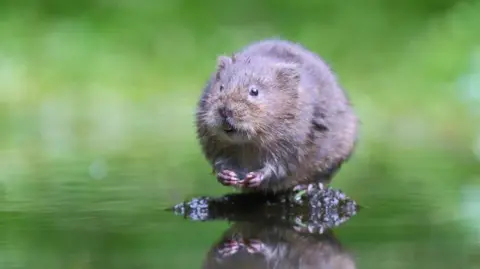The struggle for the conservation of water voles, once a common sight across south Wales, has taken a unique twist with an innovative approach that involves edible glitter. This small furry creature, known for its semi-aquatic lifestyle and resemblance to a brown rat, has seen an alarming 90% decline in its population over the last thirty years, pushing it to the brink of extinction. As efforts to preserve this vulnerable species continue, conservationists from Nature Conservation Cymru are now exploring unconventional methods to track their movements in the wild, engaging both the public and scientific community in this critical endeavor.
Traditionally residing in lush wetland areas, water voles have been forced into fragmented habitats due to human intrusion, the draining of wetlands, and the introduction of voracious predators such as the American mink. The drastic decline in their numbers has left them effectively wiped out in many locations, with only a few remaining colonies still hanging on. To combat this, experts turned to a fun and sparkling solution: edible and biodegradable glitter, designed to be both alluring and harmless to the voles.
Rob Parry, the chief executive of Nature Conservation Cymru, revealed the genesis of this glitter project, stating that past conservation efforts for other species, particularly badgers, have successfully used similar approaches. By mixing glitter with attractants such as peanuts, they could monitor wildlife behavior. In the case of water voles, the use of colorful glitter mixed with appealing food provides a means of tracking their location and movements in their natural habitat.
The initial trials involve captive-bred water voles, part of a broader initiative led by Natural Resources Wales (NRW) to reintroduce these critters into the wild. The edible glitter is applied to favorite foods, like apples, which although not typically part of their wild diet, provide necessary nutrition and are favored during captivity. The glitter not only sparks curiosity but also serves the critical function of allowing researchers to monitor their dietary habits and subsequent movements through their waste.
This glitter application process hopes to yield valuable data, enabling conservationists to understand the extent of water voles’ ranges and their preferred habitats. Different colors of glitter could indicate various families of voles, giving a clearer picture of their population dynamics and movements. The data gleaned from this approach will be vital in determining how to better manage and protect wetland ecosystems crucial for the survival of the species.
As exciting as it sounds, the project rests on several considerations: whether the glitter retains its shine long enough to be identifiable in the vole’s droppings, and whether the voles are willing to consume the glitter-enriched food. During preliminary observations, it was noted that within an hour, most of the glittery apples had disappeared, an encouraging sign of acceptance.
Mr. Parry emphasized the urgent need for such interventions, citing that human actions over the years have paved a detrimental path for water voles, leading to adverse habitat alteration and increased predation. As they await the glitter’s viability, conservationists remain hopeful, and the success of this initiative could lead to more comprehensive strategies for enhancing habitat conditions for the water voles, particularly by mitigating invasive species threats, managing grazing, and restoring wetlands.
With a recent observation of glittery droppings from these delicate mammals, the conservation team celebrated a small but significant victory in their relentless pursuit of saving the water voles. The glitter project exemplifies how creativity in conservation can mesh science with practical solutions to address one of the pressing environmental challenges of our time. As the journey unfolds, this sparkling experiment stands as a testament to the lengths conservationists are willing to go to protect and revive an endangered species, driving home the message that innovative thinking is crucial in contemporary wildlife management.



